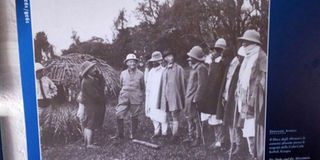Conquering the Lunae Montes

Daring. RIGHT. The Duke of Abruzzi with his fellow expeditioners in the Rwenzoris. Courtesy photo
What you need to know:
SNOWCAPED. The Rwenzoris have a number of mountain peaks named after early explorers to Uganda, beside the popular Margherita peak on Mount Stanley, writes ERIC NTALUMBWA.
Following the successful Rwenzori expedition, and numerous voyages around the world, the Embassy of Italy, with the participation of the Ministry of Tourism, Wildlife and Antiquities of Uganda, has organised a conference and photo exhibition on the expeditions of Luigi Amedeo of Savoy-Aosta, Duke of the Abruzzi.
The event dubbed: From the North Pole to the equator-The duke of Abruzzi’s exploration voyages, commenced on Friday 27 April 2018 at Makerere University’s Art Gallery with Professor Ephraim Kamuntu, the guest of honour. The exibition, which climaxes on May 28, 2018, has a number of distinguished panelists.
Exploration of Ruwenzori
In 150 AD, when the Greco-Roman astrologer Claudius Ptolemy wrote about the Lunae Montes (Mountains of the Moon) he was referring Rwenzori mastiff. Interestingly, in 1861, when John Hanning Speke, an English explorer, saw the Virunga volcanoes, he associated them with Ptolemy’s description.
In 1864, when Sir Samuel Baker, a British explorer, visited Lake Albert, northeast of the Rwenzori Mountains, he reported his glimpse of “great mountainous masses away in the distance, to the south of Lake Albert.” He referred to them as the Blue Mountains.
Later, the controversial yet popular Sir Henry Morton Staley was sent on an expedition in 1887 to rescue the German explorer Emin Pasha. Stanley made a definite sighting of the Rwenzoris. He proclaimed them Snow Mountains. He called the mountains with the name most frequently used by the native Bakonjo – Ruwenzori – which means Cloud Master.
Meanwhile, the Baganda who viewed the beautiful, often mist-shrouded non -volcanic mountains from afar called them Gambalagala to meaning ‘My eyes hurt’ in reference to the shining snow.
The Duke of Abruzzi expedition
“I hope that a man devoted to his work, a passionate mountaineer, takes the time to focus on the Rwenzori mountains, to study and explore them from the top to the bottom, through their huge ridges and deep channels,” Stanley said during a conference organised by the Royal Geographical Society (RGS) in 1891.
Upon publishing part of this speech in the British explorer’s obituary, Prince Luigi Amedeo di Savoy, the Duke of Abruzzi, read it and was deeply impressed. He decided to attempt the enterprise.
Born to the King of Spain, Abruzzi was a Spanish mountaineer and explorer. On April 16, 1906, he left Naples for Mombasa Port, and arrived on May 3, 1906. Men and equipment were transported by train from Port Florence in Kisumu in Kenya and arrived in Entebbe by ferry.
The team needed about 300 porters to proceed to Fort Portal. Early in the morning of May 28, 1906, from the summit of the hills between Lake Edward and Albert, “the icy peaks of the great range suddenly appeared high in the sky to the West. They were about seventy kilometres away and looked as if they were suspended in the air.”
The following day, the expedition arrived in Fort Portal. They crossed Mubuku River Valley and as the caravan proceeded, the vegetation became increasingly lush and wild and the land exceptionally humid and slippery, making the hike progressively more difficult. On June 7, after a final climb, the expedition arrived in Bujongolo at 3798 metres on the foot of the mountains they were planning to explore.
On June 18th, the duke reached two highest summits of the Rwenzori Range, in the Stanley group. They were named Margherita Peak (5125m) and Alexandria Peak (5105m). After completing these explorations, the exploratory campaign recommenced on June 22nd and reached Mount Speke and Mount Emin’s highest peaks, named Vittorio Emanuele Peak (4901 M) and Umberto Peak (4815 m), respectively.
They later explored two mountain groups. They started with Mount Luigi di Savoia. Afterwards, they reached the farthest one, which was then named Mount Gessi. On this latter’s extreme summit, called Lolanda peak (4769 M), the duke took a long break, as if wanting to impress on his memory all the beauty in front of him before turning back to join his companions for the journey back home.
The duke, adapted to the naming of peaks according to Victorian historicals, adding some Italian names to honour the Italian royal family- Margherita, Elena, Vittorio Emanuele, Lolanda, Umberto. He sought for permission and gained approval from the British Royal Geographic Society, because the mountain range was under a British Protectorate.
This expedition produced important scientific results, and an excellent topographical survey of the range was completed with information on the areas of the glaciers.




